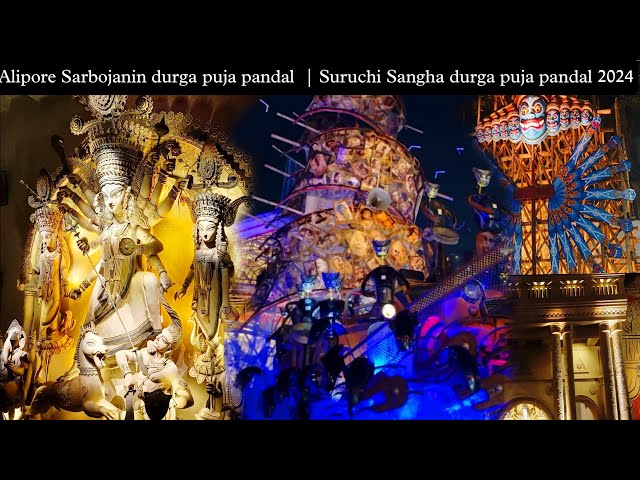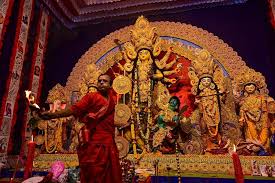In the heart of North Kolkata, Shyampukur Sarbojanin Durga Puja stands as a testament to over a century of 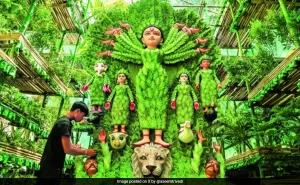 tradition, authenticity, and communal warmth. In 2024, this revered celebration embraced its storied past with a deeply nostalgic theme—“Childhood Tales & Local Memories.” Operating for more than 113 years, Shyampukur remains rooted in tradition, particularly through its iconic ekchala idol form, retaining the very same height and clay proportions passed down through time. This year, it skillfully balanced heritage with heartfelt storytelling, bringing vintage charm and neighbourly spirit to center stage.
tradition, authenticity, and communal warmth. In 2024, this revered celebration embraced its storied past with a deeply nostalgic theme—“Childhood Tales & Local Memories.” Operating for more than 113 years, Shyampukur remains rooted in tradition, particularly through its iconic ekchala idol form, retaining the very same height and clay proportions passed down through time. This year, it skillfully balanced heritage with heartfelt storytelling, bringing vintage charm and neighbourly spirit to center stage.
A Legacy of Tradition and Authenticity
Founded as one of Kolkata’s earliest Barowari Durga Pujas, Shyampukur Sarbojanin has relentlessly preserved its austere rituals and aesthetic. The ekchala idol, towering at approximately 5.5 feet, is crafted with just 14 handfuls of clay (“poa”), with no embellishments or modern stylistic deviations. The 2024 celebration marked a return to this pure form—eschewing thematic innovation in favor of the soulful simplicity and devotional continuity that have earned this puja its revered status.
In a world of ever-changing festive theatrics, Shyampukur’s steadfast commitment to ritual precision became its boldest statement in 2024.
Theme: “Childhood Tales & Local Memories”
This year’s theme wove classic childhood imagery—kites fluttering above ramshackle homes, old film projectors casting silent stories, simple toys, and village-style games—into the pandal’s visual tapestry. It was an ode to bygone days when schoolyards, street games, and homemade festivals defined joy, not technology or grandeur.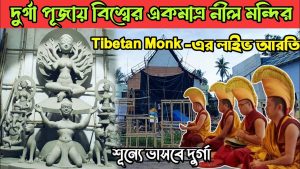
Walking through the entry arch felt like stepping into a sepia-toned memory: paper kites tied to bamboo sticks, earthy murals depicting childhood games, and hand-painted signboards that read—“Bidey Khela,” “Gachh Bagan,” “Bhuter Adda.”
Visual Design: Rustic, Retro, Resonant
The pandal’s design brilliantly echoed the theme:
-
Muted, nostalgic color palette—sepia browns, faded greens, and soft ochres—recoiled sophistication in favor of sincerity.
-
Old-school street lamps, slightly rusted and flickering, evoked the evenings of lantern-lit alleys.
-
Props and tableaux, like wooden school desks, spinning tops, block-y wooden toys, and film-reel installations, recreated tiny pockets of collective memory.
-
Alpona flooring, in traditional folk patterns, guided visitors through memory lanes toward the central chamber.
The effect was immersive—quiet yet emotive.
Devotion at the Core: The Idol and Rituals
At its heart stood the ekchala Durga idol, calmer yet commanding. Draped in classic saree folds and minimal jewelry, her gentle face radiated maternal warmth. The lion and demon were rendered in understated simplicity, keeping focus on devotion, not dramatics.
Daily rituals preserved their ancient rhythms:
-
Bodhon (invocation) at dawn,
-
Pushpanjali with garlands at the foot of the idol,
-
The Sandhi Puja, performed at the Ashtami–Navami transition with fervent dhunuchi dances,
-
A serene Sindoor Khela on Vijayadashami, with vermillion and fervor undiminished by age.
The worship remained intimate—without speakers, without fanfare. Just the reverberation of dhaks and heartfelt prayers.
Community & Cultural Connection
Shyampukur’s strength lies in its grassroots essence. In 2024, nearly every pujari, actor, or volunteer hailed from the neighborhood. Craftspeople from local families curated décor, and neighbors contributed toys, frames, and vintage items for exhibit.
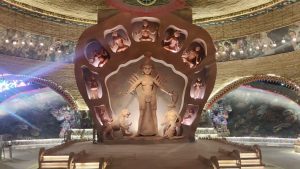 The small fair outside showcased local artists’ handmade dolls, storybooks in Bengali fonts, and homemade sweets—thus supporting the very neighborhood that sustains the festival.
The small fair outside showcased local artists’ handmade dolls, storybooks in Bengali fonts, and homemade sweets—thus supporting the very neighborhood that sustains the festival.
Cultural Programs: Nostalgia in Performance
Evenings at the pandal were sprinkled with nostalgic entertainment:
-
Folk recitals—songs of childhood, lullabies, seasonal tunes—performed under dim lamp lights.
-
Street theater skits depicting schoolyard life, kite-flying competitions, or Chaitra melas (spring fairs).
-
Puppet shows with retro string puppets played out village scenes—monsoon, harvest, folk tales—all by local youth.
Every act was a breath of memory, inviting older visitors to reminisce and children to feel rooted.
Signature Scenes from the Pandal
-
Entrance lane decked with hand-made kites, their strings trailing overhead like captured dreams.
-
Side yard with an actual wooden projector, showing grainy childhood photographs of Kolkata families.
-
Kids’ corner with simple toys—spinning tops, marbles, clay whistles—encouraging playful interludes.
-
Bookstall with vintage comics, school primers, and old magazines.
-
Alpona-adorned floor, guiding devotees into ritual space with measured elegance.
-
Rope swings hung from bamboo supports—a nostalgic pause for the young at heart.
-
Rustic benches, reused from local verandahs, inviting quiet reflection.
-
Musical evenings with harmonium and tabla echoing lullabies and childhood rhymes.
-
Mementos wall, where residents pinned old photographs of family Durga celebrations.
Community bulletin board, where neighborhood stories post-dated back decades—festive memories, harvest tales, tips-of-the-day.
Visitor Tips: Maximizing the Experience
-
Visit early (morning) for serenity and less crowd. The rituals then feel deeply soulful.
-
Walk barefoot inside—it amplifies connection to ritual ground and alpona grace.
-
Engage with locals—ask about childhood games or stories behind props.
-
Sample street food—local lassi, phuchka, or jhal muri sold nearby carry taste-memory.
-
Stay for evening programs—especially puppet shows and folk recitals under lamp-light.
Final Reflection: A Festival of Living Memory
In a city swept by grand themes and imaginative pandals, shone not through spectacle but soul. It whispered of quiet strength—of how festivals anchor us to our roots, to the simplicity of childhood, to neighborhood warmth. It reminded us that heritage lives on not by creating anew—but by lovingly preserving what was, how it once felt, and why it mattered.
This Durga, in her modest pose, stood not just as mighty Mother, but as keeper of histories—of childhood laughter, of homely rituals, and of traditions passed quietly yet unwaveringly through generations.
If Devotion is memory, and Memory is home, then in 2024, Shyampukur summoned us all home.

